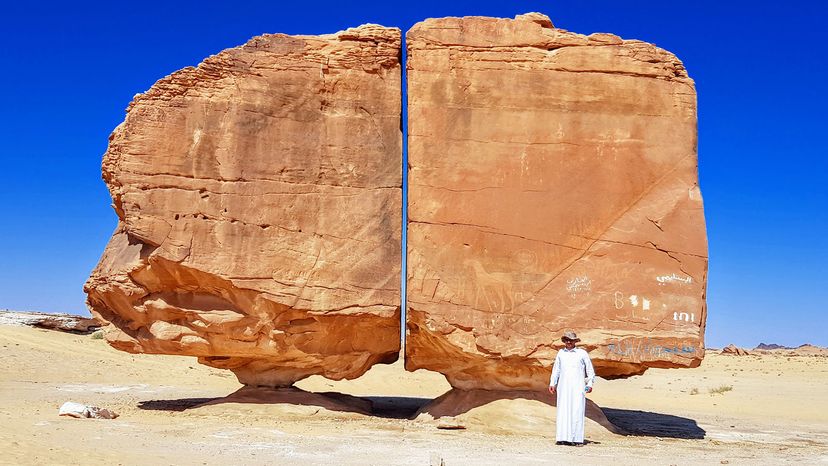Located in Saudi Arabia’s Tayma Oasis — the site of Saudi Arabia’s oldest human settlement — Al Naslaa is comprised of twin sandstone rocks, balanced atop naturally formed pedestals — with a smooth gap running vertically between them, so precise it looks as if it was carved with a laser beam.

The split in Saudi Arabia’s Al Naslaa rock formation is so laser perfect that many wonder whether nature could have created such a clean break. WIKIMEDIA COMMONS (CC BY SA 4.0)
Scientists can’t explain exactly how the 4,000-year-old geological formation was split down the middle, but the side-by-side boulders — each 20 feet (6 meters) tall — have the additional lure of visible petroglyphs that are thousands of years old. One of the most notable glyphs carved into the sandstone is an image of a person leading a horse that resembles an Arabian, one of the world’s oldest horse breeds still in existence whose origins can be traced to Saudi Arabia in the seventh century, well before Al Naslaa was carved by human hands.
Ancient Gods, Aliens, Lasers or Just Water?
These perfectly balanced boulders have been the subject of many an origin story, with perhaps the most bizarre being space aliens. Social media users, including news aggregate Acerca del Mundo on its Facebook page, have pondered whether the precise cut could have been made by alien visitors possessing advanced technology.
“Some believe that this is the creation of the ancient gods or aliens. Considering that the formation looks as if it had been cut by a well-aimed laser, some believe that an alien descended into the Tayma Oasis and shattered the rock with advanced technology not available to humans in the formation of it,” Acerca del Mundo posted.
Others believe the rock sits upon a fault line. This theory posits that the split in the rock was created when a weak spot was affected by a shift in tectonic plates.
Another theory posits that a “joint” within the rock may have split. A joint is an area within a rock, in this case sandstone, that becomes worn away and then separates the larger formation. Notably, joints found within sandstone rocks like Al Naslaa are more likely to exhibit vertical separations.
A freeze-thaw weather cycle could be credited with the Al Nalsaa formation, according to a third theory. If water seeped into the ancient boulder when it was still in one piece, then froze and expanded and later thawed, a crack would have formed and eventually divided the boulder.
Another interesting suggestion is that ancient humans are responsible for the awe-inspiring crack. Evidence remains that an unknown ancient civilization carved images into the rock, so it is possible these same people may have used tools to divide the rock into two large pieces, perhaps as artistic expression.
Whatever the cause of the split, the incredibly smooth edges were probably once jagged, then worn down and polished by thousands of years of blowing sand. Nature may be the most creative artist of all.











